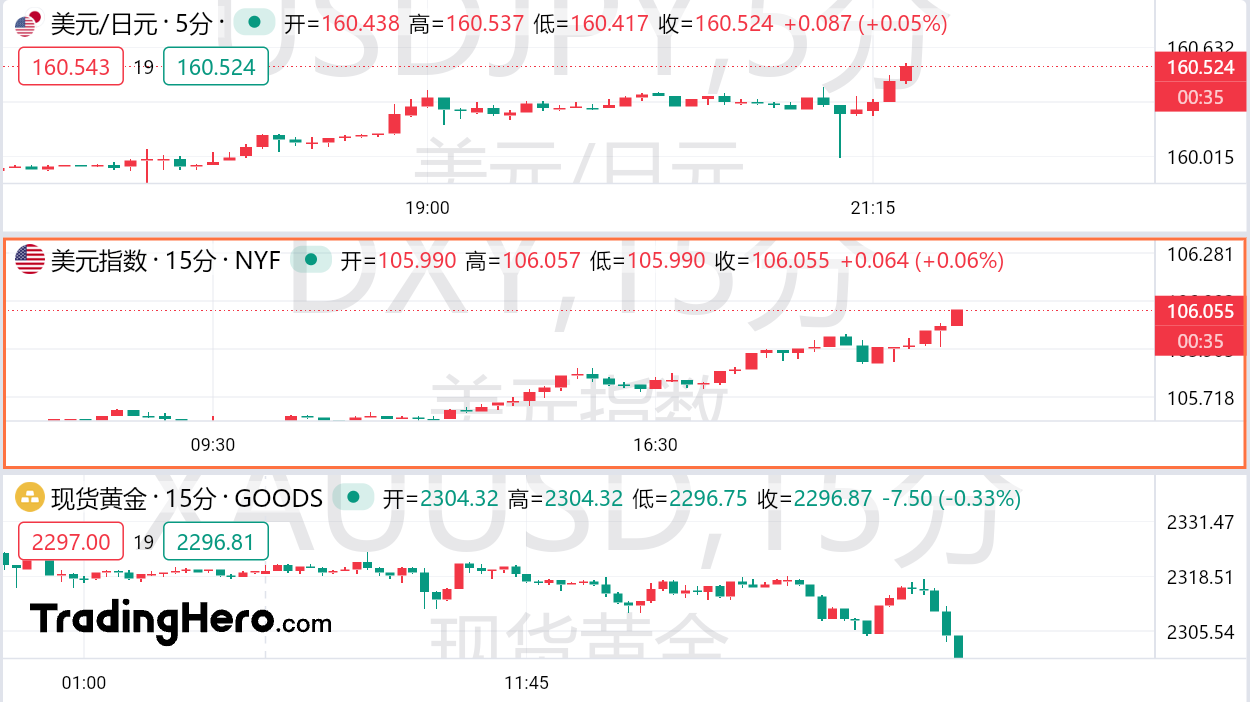The continuous decline in the yen triggered a chain reaction! Gold breaks the 2300 mark
The exchange rate of the yen against the US dollar fell 0.4% to 160.4 on Wednesday, the lowest level since 1986, breaking through the level when the Japanese authorities interfered in the foreign exchange market in April, triggering speculation that the authorities may soon be forced to support the yen again.
Before the US market, after Japan's chief foreign exchange officer Masato Kanda issued another verbal warning, the yen fell 40 points against the US dollar in the short term, but then quickly rebounded to a high of 160.48, a new high since 1986. Affected by the weakening yen, the US dollar index hit 106 upward, for the first time since May 1. The strengthening of the US dollar dragged down precious metals, and spot gold fell below the $2,300 mark.

Masato Kanda recently stated that he is seriously concerned about the recent sharp depreciation of the yen and will take appropriate measures to deal with foreign exchange issues as needed. He pointed out that the current fluctuation in the yen is unquestionably one-sided.
The yen has depreciated by more than 12% since this year, causing import prices to rise, harming the interests of Japanese consumers and making companies increasingly uneasy.
Despite Japan's increase in borrowing costs, the huge interest rate gap between the US and Japan is putting pressure on the yen. The yen's next major pain point may come from Friday's reading of the inflation index favored by the Federal Reserve, which is the key to its monetary policy outlook.
Erik Nelson, macro strategist at Wells Fargo Bank in London, said: “Japan's Ministry of Finance's remarks in recent days shows that people's concerns have increased.” He expects officials to hold out until the yen falls to 165 against the US dollar before entering the market. Banks, including Bank of America, also believe that this level is the new “bottom line” for the authorities.
The risks facing Japan are high, and it has spent a record 9.8 trillion yen ($61.1 billion) in recent rounds of intervention. Citigroup estimates that the country has between $200 billion and $300 billion to fund any operation.
But so far this week, the response from Japanese officials has been limited to verbal warnings.
Earlier, Japan's Finance Minister Shunichi Suzuki said that they are closely monitoring market developments and will take all possible measures as needed. On Monday, Masato Kanda warned that the authorities are ready to intervene 24 hours a day if necessary, while reiterating that they are not intervening at a specific level.
Win Thin, head of global market strategy at Brown Brothers Harriman & Co in New York, said: “If the volatility of the yen against the dollar starts to become chaotic above the 160 level, the Japanese authorities may step in to stabilize the trend of this currency pair. Buying USD/JPY before the Bank of Japan takes a tougher stance has the least resistance.”
Bloomberg macro strategist Cameron Crise said that according to my model, levels around 161 or slightly above 161 are still the most likely threshold for the Japanese authorities to intervene.
Japan's previous measures to support the national currency have attracted overseas attention, and the US Treasury Department added Japan to the “Exchange Rate Manipulation Watch List” last week.
Although the US does not list Japan (or any other trading partner) as an exchange-rate manipulator, US officials wrote, “In large, freely traded foreign exchange markets, intervention should only take place under very specific circumstances and after proper prior consultation.”
However, the US data released on Friday may ease some of the pressure on the yen. Economists predict that core personal consumption expenditure (PCE) inflation will slow somewhat in June, which may reinforce the reasons for the Federal Reserve to reduce borrowing costs this year.
Many strategists say that the volatility of the foreign exchange market is still relatively low, and it is currently difficult for the authorities to intervene. For most of this month, the implied one-month volatility of USD/JPY hovered below 9%, a sharp drop from 12.4% at the end of April.
Roberto Cobo Garcia, head of foreign exchange strategy at Bank of Spain G-10 in Madrid, said: “Considering the dollar demand at the end of the quarter and the fact that market volatility is still under control, the Japanese authorities may wait a little longer to intervene. If they want to step in again, the volatility needs to rise even more.”
 Index Options
Index Options CME Group
CME Group Nasdaq
Nasdaq Cboe
Cboe TradingView
TradingView Wall Street Journal
Wall Street Journal